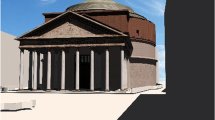Abstract
In this paper, we describe the design and implementation of the Immersive Learning Environment for Visual Arts (ILEVA), which is a system that employs virtual reality technology that allows novice users to immerse into their own artworks and experience the virtual space interactively, thus providing a whole new perspective of creating and experiencing art forms to the users. This paper describes the design and architecture of ILEVA and presents a case study with a group of high school students studying in Visual Arts. The result of the work, user responses and evaluation will be discussed .
Access this chapter
Tax calculation will be finalised at checkout
Purchases are for personal use only
Similar content being viewed by others
References
Visual Arts Curriculum Guide (2003). http://www.edb.gov.hk/attachment/en/curriculum-development/kla/arts-edu/references/va_guide_p1_s3_e.pdf. Accessed 29 Jan 2014
Cruz-Neira, C., Sandin, D.J., DeFanti, T.A., Kenyon, R.V., Hart, J.C.: The CAVE: audio visual experience automatic virtual environment. Commun. ACM 35(6), 64–72 (1992)
Jürgen, S., Dianne, C., Bradley, D.K., Carolina, C.-N.: Dynamic Statistical Graphics in the CAVE Virtual Reality Environment (1996)
Disz, T., Papka, M., Pellegrino, M., Stevens, R., Taylor, V.: Virtual reality visualization of parallel molecular dynamics simulation. In: Proceedings 1995 Simulation Multiconference Symposium, pp. 483–487 (1995)
Vote, E., Acevedo, D., Laidlaw, D., Joukowsky, M.: Discovering petra: archaeological analysis in VR. IEEE Comput. Graph. Appl. 22(5), 38–50 (2002)
Ye, N., Banerjee, P., Banerjee, A., Dech, F.: A comparative study of assembly planning in traditional and virtual environments. IEEE Trans. Syst. Man, Cybern. Part C: Appl. Rev. 29(4), 546–555 (1999)
Bochenek, G.M., Ragusa, J.M.: Virtual collaborative design environments: a review, issues, some research, and the future. In: Proceedings of the Management of Engineering and Technology, PICMET 2001, vol. 722, pp. 726–735 (2001)
SketchUp (2016). http://www.sketchup.com/. Accessed 10 Feb 2016
Unity (2016). http://unity3d.com/. Accessed 10 Feb 2016
MiddleVR (2016). http://www.middlevr.com. Accessed 10 Feb 2016
McGinity, M., Shaw, J., Kuchelmeister, V., Hardjono, A., Favero, D.D.: AVIE: a versatile multi-user stereo 360 interactive VR theatre. In: Proceedings of the 2007 Workshop on Emerging Displays Technologies: Images and Beyond: The Future of Displays and Interacton, vol. 2. ACM (2007)
Acknowledgements
Our thanks to the Quality Education Fund from the Education Bureau of the Hong Kong SAR Government for partly funding the workshop.
Author information
Authors and Affiliations
Corresponding author
Editor information
Editors and Affiliations
Rights and permissions
Copyright information
© 2016 Springer International Publishing Switzerland
About this paper
Cite this paper
Chan, L.K.Y., Yuen, K.S.G., Lau, H.Y.K. (2016). Immersive Learning Environment for Visual Arts. In: De Paolis, L., Mongelli, A. (eds) Augmented Reality, Virtual Reality, and Computer Graphics. AVR 2016. Lecture Notes in Computer Science(), vol 9769. Springer, Cham. https://doi.org/10.1007/978-3-319-40651-0_18
Download citation
DOI: https://doi.org/10.1007/978-3-319-40651-0_18
Published:
Publisher Name: Springer, Cham
Print ISBN: 978-3-319-40650-3
Online ISBN: 978-3-319-40651-0
eBook Packages: Computer ScienceComputer Science (R0)




